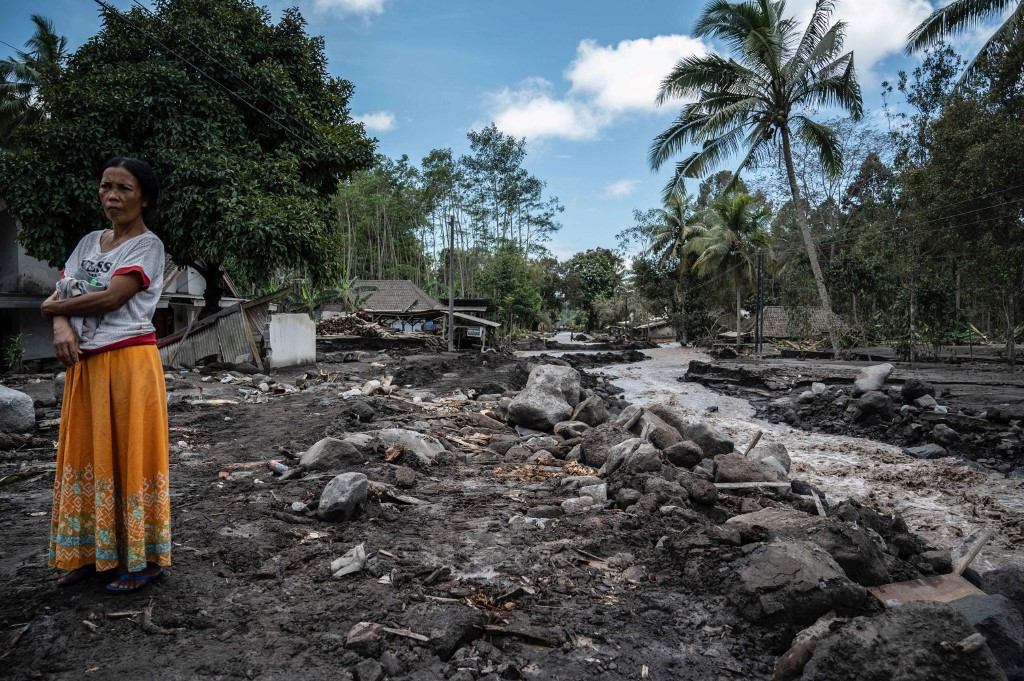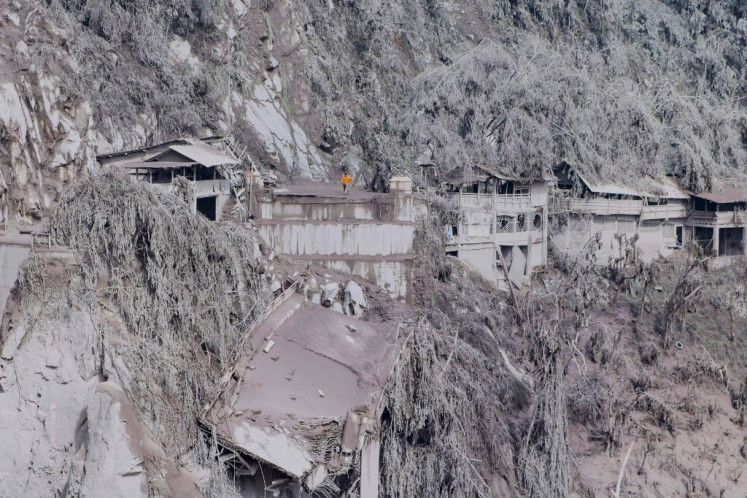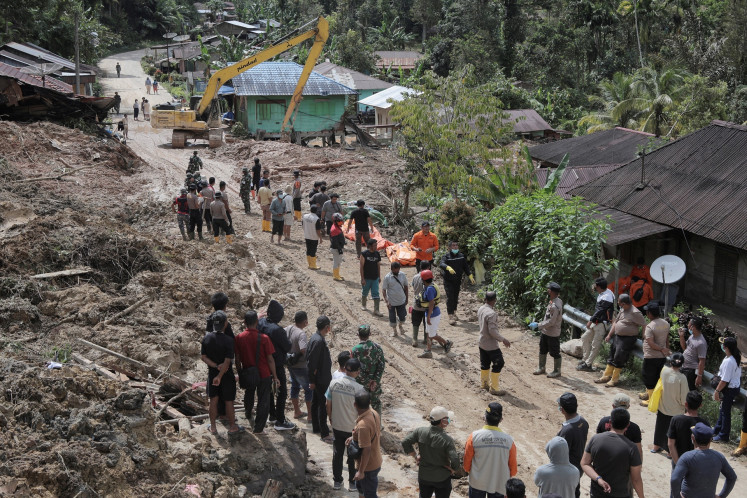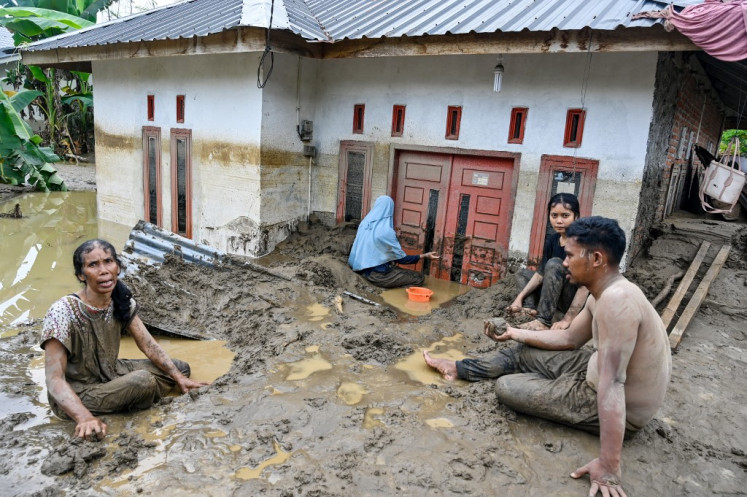Popular Reads
Top Results
Can't find what you're looking for?
View all search resultsPopular Reads
Top Results
Can't find what you're looking for?
View all search results'No warning': East Java village caught off guard in Semeru disaster
"There was no warning. If there had been, there wouldn't have been victims, right?" said Minah, of her cousin Rumini, who died clutching her elderly mother as their kitchen roof caved in.
Change text size
Gift Premium Articles
to Anyone
I
n the wake of the deadly Semeru eruption in Lumajang, East Java, the entwined bodies of a mother and daughter encased in molten ash have come to symbolise what many living in the shadow of the volcano feel went wrong.
"There was no warning. If there had been, there wouldn't have been victims, right?" said Minah, of her cousin Rumini, who died clutching her elderly mother as their kitchen roof caved in.
Nestled at the base of volcano, their village of Curah Kobokan was among the worst-hit when Semeru spectacularly erupted on Saturday, ejecting ash clouds and pyroclastic flows that killed 43 people and left dozens missing.
The eruption of Java's tallest mountain has raised questions about the effectiveness of Indonesia's disaster warning system, and the dangers of rebuilding on the volcano's fertile but precarious slopes.
Officials said some messages were sent to local administrators but acknowledged they did not result in an evacuation order, in part because the volcano's activity is hard to predict.
Warnings to evacuate are normally relayed by the National Disaster Mitigation Agency (BNPB), such as in 2017 when it ordered 100,000 people living near Bali's rumbling Mt Agung to immediately leave the danger zone.
The BNPB did not immediately respond to Reuters' request for a comment.
In Javanese, the village's name Curah Kobokan means "pouring bowl", a reference to the river that snakes by it. Once a source of life, the river would also become the community's downfall.
When Semeru erupted, the river carried thick flows of lava and ash directly into Curah Kobokan, now a field of gray ash piled as high as the powerlines, a few triangular roofs jutting out of the newly formed disaster landscape.
Residents say the air grew blazing hot and pitch black in seconds. People screamed and fled in panic, some taking refuge in a prayer house, others huddled in a concrete drain.
Of eight residents Reuters interviewed, not one said they received warning of an impending eruption.
"If there had been warning, people would have evacuated. Instead in a matter of minutes, lava streamed down and a lot of people died," said 41-year-old Irawati, whose husband was knocked unconscious as they tried to escape.
'No Time To Run'
An archipelago of 270 million sitting atop the Pacific Ring of Fire, Indonesia is one of the most disaster-prone nations on earth. The devastation wreaked by Semeru can be ascribed to a deadly confluence of factors, for which no one wants to take the blame.
The head of geological agency, Eko Budi Lelono, says messages were sent to local officials warning of hot ash clouds. The river near Curah Kobokan, he said, was marked red on the map.
Ash covers houses and trees on the slopes of Mount Semeru in Lumajang on December 5, 2021, the day after a volcanic eruption on the mountain that killed at least 14 people. (AFP/Aman Rochman)"In the future, we can't blame one another, but we need to synergise more," Eko says.
Dino Adalananto of the East Java disaster mitigation agency says the warnings were passed on to local resilience officers but there were no specific orders to evacuate. The head of Curah Kobokan could not be reached.
Experts say the nature of the eruption, a cave-in of the lava dome possibly triggered by external factors such as heavy rain, was also difficult to catch ahead of time.
"Whatever the actual trigger was, it was the instability of this lava dome at the summit that collapsed and those things are very hard to predict," said Heather Handley, a volcano scientist at Australia's Monash University.
Eruptions triggered by lava dome collapses account for about 6 percent of all volcanic eruptions, says Handley, with more research needed to understand the characteristics and causes.
Another causal factor for the tragedy is the reality of life on Semeru's slopes, where over the decades communities have become inured to volcanic activity, including the summit letting off steam.
As disaster officials survey the devastation, some 100,000 homes damaged or destroyed, there is growing talk about the danger of living so close to the mountain, with Indonesian President Joko "Jokowi" Widodo saying at least 2,000 homes will be moved.
With 142 volcanoes, Indonesia has the largest population globally living in close range to a volcano, including 8.6 million within 10km (6.2 miles).
"What needs to be explained to people is the areas where the lava flows, our recommendation is don't live there anymore," said the geological agency's Eko.
"When they're there, there's no time to run."










